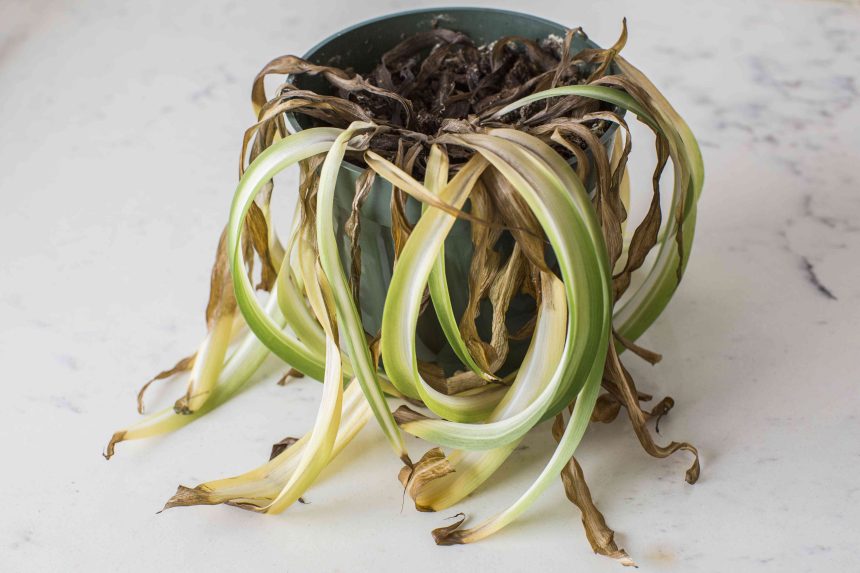It’s hard not to feel pessimistic at the first signs of a struggling plant. Usually, it starts with the leaves—once they turn yellow or brown or fall off completely, your mind shoots to the worst possible scenario.
Of course, your plant might be beyond saving, but don’t throw in the towel just yet. Below, we’ll walk you through a few signs that your plant might have reached the end of its road and how to fix the damage.
5 Signs Your Plant Might Be Struggling
Emilija Manevska / Getty Images
First of all, if you think your plant is struggling, don’t freak out; people often panic at any sign of damage, but a lot of it is manageable. Here are some signs your plant might show you to let you know it needs help.
- Yellowing leaves. This is one of the most common issues, and it could mean that the plant is getting too little or too much water. But sometimes, it can just mean that a leaf is done and is ready to be cut off.
- Brown or curling leaves. Brown leaves can often be a sign of underwatering. Curling leaves could also be a sign of underwatering, or the result of pest damage.
- Broken or damaged roots. Try to get a look below the surface—if anything is broken, damaged, rotten, or desiccated, a simple trim could help.
- Squishy leaves. This could be a sign your plant might be unhappy with the temperature. A happy plant should have turgid, healthy-looking leaves with no signs of distress.
- Pests. Unfortunately, sometimes the damage is caused by an outsider intruder. In this case, it’s important to monitor your plant so you can determine what kind of pest you’re dealing with.
Want more gardening tips? Sign up for our free gardening newsletter for our best growing tips, troubleshooting hacks, and more!
5 Ways to Revive Your Plant
The Spruce / Anastasiia Tretiak
- Find the source of the problem. To find a solution, it’s key to know what the problem is. That’s the only way you can make sure you’ve solved it and can revive your plant in the long term.
- Ditch the watering schedule. If you’re noticing a consistent issue with your plant’s leaves, it’s time to assess your watering schedule and make necessary changes. Pay attention to the signs your plants provide, and water only when dry.
- Chase the right light levels. If you’re dealing with an unhappy houseplant, it could be as simple as changing the location. Determine the ideal light levels for that particular plant and assess.
- Do some root triage. Gently dig up your plant (if it’s small enough) and take a look at the root system. Any problem areas can be trimmed off; just need to be careful, and give it some extra shade protection and TLC as it regenerates.
- Check to see if you’re plant is going dormant. Some plant owners might suspect their plant is dying when it’s simply going dormant for the season. Check the roots for signs of health: If they look firm or plump, your plant is in good shape.
Is Your Plant Dead or Dormant?
In some instances, a dead plant might be dormant—and this is a very important distinction. Investigate what the dormant state of your specific plant is and evaluate based on this. Many plants look shriveled up and dead, but are actually just conserving water and energy during the cold winter months.
Our Best Tips to Avoid Killing Another Plant
The Spruce / Krystal Slagle
Assess the Whole Plant—Not Just a Few Leaves
If you notice one yellow leave or a brown area, don’t automatically assume the worst. Instead, assess the plant as a whole before doing anything drastic. If the rest of the plant looks healthy, one leaf may have just lived its life cycle and needs to be removed.
Determine If You Have a Pest
If your plant is showing definite signs of a pest infestation, try to figure out what exactly you’re facing. Then, make a plan and monitor accordingly.
Avoid Root Rot
While overwatering can often be resolved by simply letting your plant dry out, it’s important to avoid root rot. If you suspect your plant is suffering from overwatering, pause and assess the roots before you push it past the point of no return.
Plants can often recover if they have a healthy foundation of growth. Simply check for anything slimy or mushy, and treat it accordingly.
Find the Right Plant for You
Even if you’ve declared yourself to be a plant killer, there really is still hope. It could be that you’ve simply been choosing plants that require a higher skill level thank you have. Rather than call it quits, try picking a new, easier plant.
Start with a very forgiving plant that can take multiple types of light and do not need lots of water; snake plants and Aglaonema are great plants to start with. Some plants even thrive on neglect, so just do your research and try again.
FAQ
-
Assess the plants and the roots before making any decisions, as they’re the best indicator of a plant’s health. If they’re completely dried out or rotten, you’re probably better off starting anew.
-
If your plant is dead it can be put into your compost pile. If the plant died because of a pest or you don’t compost, throw them away however you dispose of other organic waste.
-
If you’ve done everything and the plant is truly dead, it’s best to chalk it up to a learning experience, pull it out, and replace it with something new.






